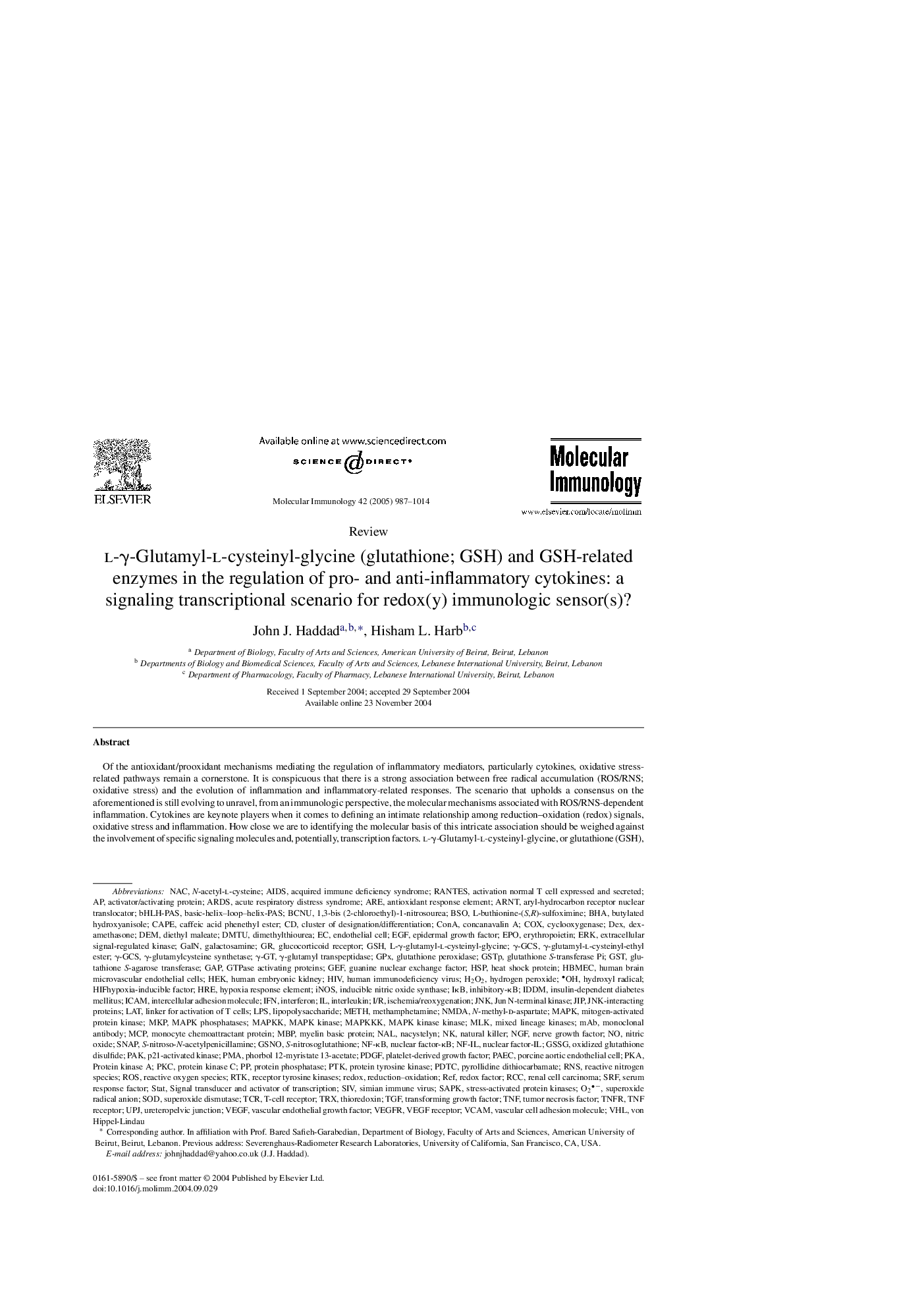| Article ID | Journal | Published Year | Pages | File Type |
|---|---|---|---|---|
| 9141810 | Molecular Immunology | 2005 | 28 Pages |
Abstract
Of the antioxidant/prooxidant mechanisms mediating the regulation of inflammatory mediators, particularly cytokines, oxidative stress-related pathways remain a cornerstone. It is conspicuous that there is a strong association between free radical accumulation (ROS/RNS; oxidative stress) and the evolution of inflammation and inflammatory-related responses. The scenario that upholds a consensus on the aforementioned is still evolving to unravel, from an immunologic perspective, the molecular mechanisms associated with ROS/RNS-dependent inflammation. Cytokines are keynote players when it comes to defining an intimate relationship among reduction-oxidation (redox) signals, oxidative stress and inflammation. How close we are to identifying the molecular basis of this intricate association should be weighed against the involvement of specific signaling molecules and, potentially, transcription factors. l-γ-Glutamyl-l-cysteinyl-glycine, or glutathione (GSH), an antioxidant thiol, has shaped, and still is refining, the face of oxidative signaling in terms of regulating the milieu of inflammatory mediators, ostensibly via the modulation (expression/repression) of oxygen- and redox-responsive transcription factors, hence termed redox(y)-sensitive cofactors. When it comes to the arena of oxygen sensing, oxidative stress and inflammation, nuclear factor-κB (NF-κB) and hypoxia-inducible factor-1α (HIF-1α) are key players that determine antioxidant/prooxidant responses with oxidative challenge. It is the theme therein to underlie current understanding of the molecular association hanging between oxidative stress and the evolution of inflammation, walked through an elaborate discussion on the role of transcription factors and cofactors. Would that classify glutathione and other redox signaling cofactors as potential anti-inflammatory molecules emphatically remains of particular interest, especially in the light of identifying upstream and downstream molecular pathways for conceiving therapeutic, alleviating strategy for oxidant-mediated, inflammatory-related disease conditions.
Keywords
NF-κBEGFLPSCOXDEXJnkmAbMCPConcanavalin ACAPEMBPBHAGSHGSTHEKNACGPXTCrEPONALERKGSSGiNOSRNSHspSRFpKaIκBN-acetyl-l-cysteineNGFNMDAN-methyl-d-aspartateAP-1HIF-1αPKCHBMECTGFBCNUPAKBSOγ-GTGSNOS-nitrosoglutathioneARNTPDGFHREVHLTrxARDSphorbol 12-myristate 13-acetateIDDMICAMVCAMRCCVEGFRTNFRSIVGalNGEFConARTKJun N-terminal kinaseGSTPMKPPDTCSAPKUPJγ-GCSMAPK phosphatasesMAPKKDemMAPKKKMLKRedox factorJIPPTKPAECS-nitroso-N-acetylpenicillamineTNFoxidized glutathione disulfide1,3-Bis (2-chloroethyl)-1-nitrosoureal-γ-glutamyl-l-cysteinyl-glycinenatural killerbHLH-PASDimethylthioureaDMTUI/Rl-buthionine-(S,R)-sulfoximinePMAMAPKMAPK kinaseMAPK kinase kinaseO2−ROSγ-glutamyl transpeptidaseγ-glutamylcysteine synthetaseHydrogen peroxideSTATAntioxidantMonoclonal antibodycyclooxygenaseSuperoxide radical anionUreteropelvic junctionerythropoietinvon Hippel-Lindaucaffeic acid phenethyl esterinflammationAIDSinterferonIFNinterleukintransforming growth factorthioredoxinDexamethasonediethyl maleateInsulin-dependent diabetes mellitusHydroxyl radicalRedoxLATSODporcine aortic endothelial cellEndothelial cellHuman brain microvascular endothelial cellsinducible nitric oxide synthaseAcute respiratory distress syndromeacquired immune deficiency syndromeSuperoxide dismutaseCytokineGAPSNAPPro-oxidantepidermal growth factorantioxidant response elementhypoxia response elementVascular endothelial growth factorVascular Endothelial Growth Factor (VEGF)platelet-derived growth factornerve growth factortumor necrosis factornuclear factor-κBserum response factorLinker for activation of T cellslipopolysaccharideSignal transducer and activator of transcriptionMETHMethamphetamineREFRANTESintercellular adhesion moleculevascular cell adhesion moleculeNitric oxideAREH2O2butylated hydroxyanisoleHIVhuman immunodeficiency virusProtein tyrosine kinaseHeat shock proteinmonocyte chemoattractant proteinProtein phosphataseGTPase activating proteinsMyelin basic proteinprotein kinase AProtein kinase Cmitogen-activated protein kinaseRenal cell carcinomaReduction–oxidationhuman embryonic kidneyextracellular signal-regulated kinasep21-activated kinasestress-activated protein kinasesGalactosamineGlutathioneGlutathione S-transferase Piglutathione peroxidasereactive nitrogen speciesReactive oxygen speciesTNF receptorVEGF receptorreceptor tyrosine kinasesT-cell receptorglucocorticoid receptor
Related Topics
Life Sciences
Biochemistry, Genetics and Molecular Biology
Molecular Biology
Authors
John J. Haddad, Hisham L. Harb,
